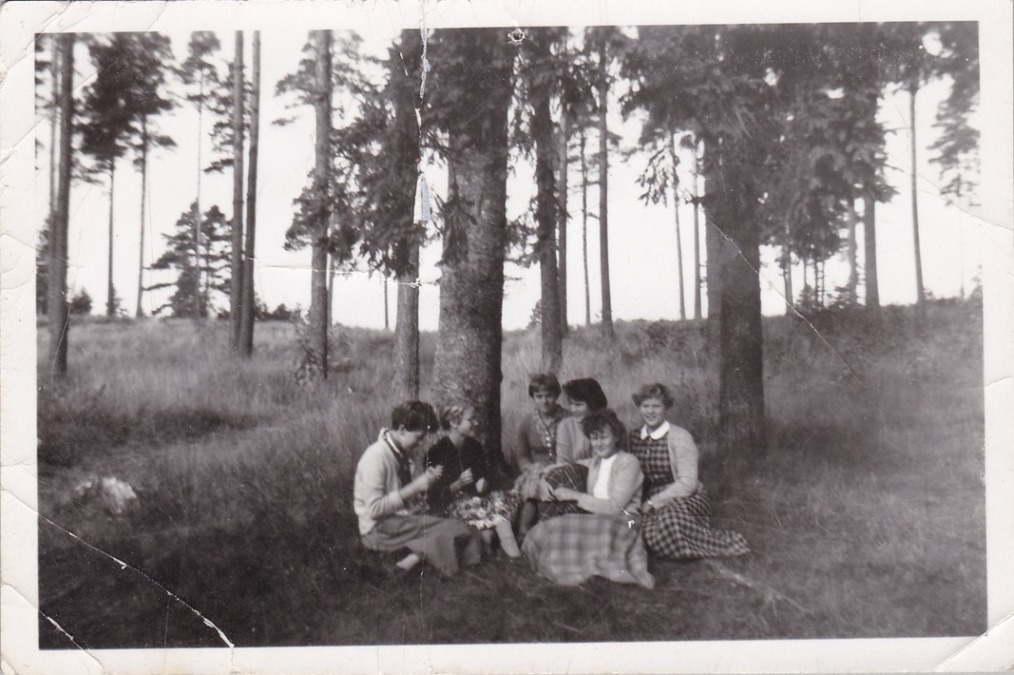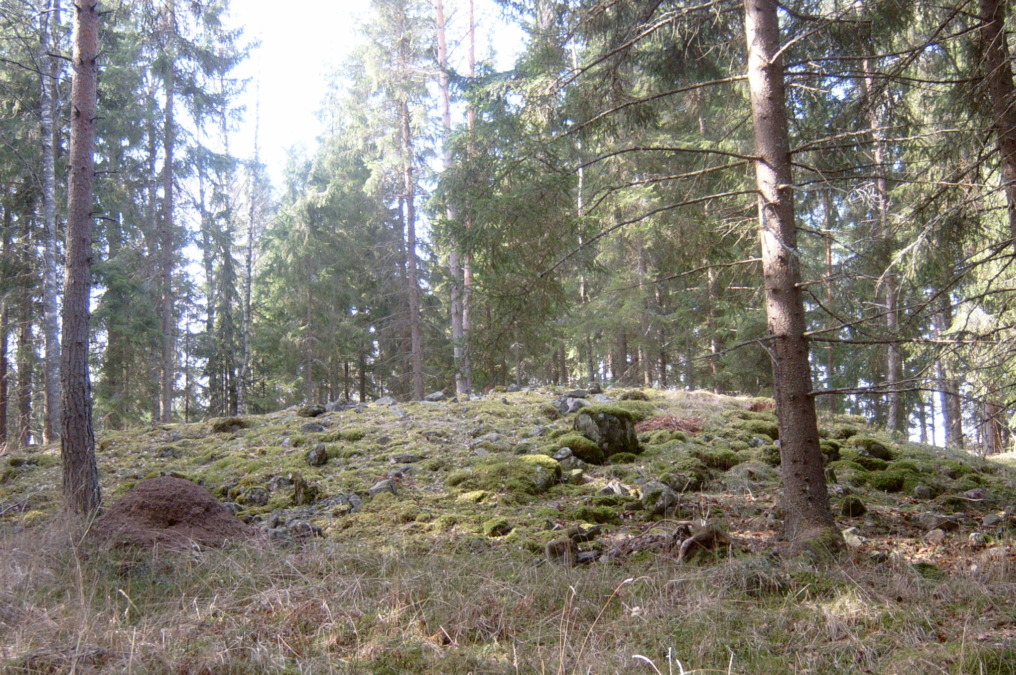On a forest hike
availability of wood for charcoal burning. Over the years, Fiskars ironworks acquired large agricultural and forested areas for its use, and along with this came around a hundred lakes. The extensive forested areas provided the workers with opportunities for hunting, fishing, and berry picking as recreational activities and supplementary income sources.

Emma and Victor Brejder are laying nets in Degersjö lake in the early 1900s. Photo: Fiskars Museum Image Collection.
Before fishing regulations were enforced in 1951 and the Fiskars Fishing Association – Fiskarsin kalastusyhdistys r.f. was founded, it was probably quite free to fish in most of the lakes around the ironworks. Nevertheless, many residents of Fiskars had their designated fishing spots, which could be passed down within families. To facilitate fishing trips, small cottages or huts were built by the lakeshores. Hiking through the forests to reach these cottages also provided a welcomed break from the otherwise heavy daily routine in the workshops during the 19th and 20th centuries.

Blacksmith Ivar Holmström with company at the Holmström cabin. Photo: Fiskars Museum Image Collection.
Due to the fire hazard, cottages could only be built on the small islands in the lakes. The first hut was built between 1882–1886 by the day laborer Semenius on Öksjö Storholmen. It was simply constructed of standing logs. The following hut was built in Lutsjö by two blacksmiths. It was constructed with wooden planks against a rock wall and furnished with two beds and a stove. During the 20th century, the number of cottages steadily increased, and in the 1960s, a clear second wave of construction can be seen with new summer cottages on Stor-Kisko and Degersjön. Summer cottages built by workers in Fiskars were an unusually early phenomenon in Finnish history.
In the forest during the 1950s
The forest provided both work and pleasure for the ironworks employees during the 1950s. Elementary school students could go to the forest to pick lingonberries for the school. Lingonberries were served during school lunches. Children also played in the forest. Especially Rövarberget (Robbers’ Rock) and Riddarberget (Knights’ Rock) behind Tulilinja (Fire Line) had such exciting names that children enjoyed playing there, for example sack racing or pretending to do forestry work. The same places were also visited during school outings.

Olga and Berthel Axelsson on an outing in the forest with their grandchildren. Berthel served as a procurator at Fiskars company from 1926 onwards. He was involved in founding Fiskars Sångarbröder male choir and was its leading figure for many years. Photo: Fiskars Museum Image Collection.
Berries like lingonberries and blueberries were also picked and taken home, and lingonberries were made into lingonberry jam. Some chanterelles were picked, but hardly any other mushrooms. Fresh chanterelles were used to make chanterelle sauce. In winter, skiing was popular, and trails partly went through the forest. There were also many paths where people walked through the forest to reach different places. Families could also hike in the village’s forests and camp overnight in tents or go fishing. In winter, it was popular to go ice fishing on the lakes.

Pojo flickor (Girl Scouts) are going to have tracking at Flacksjö in 1955. Photo: Fiskars Museum Image Collection.
When villagers working for the ironworks wanted to build a house, they could get permission to fetch logs from the forest for a fee. Likewise, for a fee, they could gather firewood. Further back in time, firewood was included in the salary. During the 1950s, many worker families had a Christmas tree from Fiskars forests. Bunches of leaves from deciduous trees and bushes were gathered for the livestock, which many families still had during the 1950s. Making birch whisks for sauna was also common.
During the 1950s, the wildlife in the forests looked somewhat different from today. For example, moose, muskrats, and grouse were quite common in the forest. However, there were no deer in Fiskars at that time, nor wolves. Some villagers hunted muskrats to earn an extra income. Muskrat skins were dried, and then sold in Helsinki.
Elk hunts at Fiskars
The vast forests around Fiskars and Skogby provided a good basis for maintaining hunting traditions within the management of Fiskars Corporation. An important person in this context was the manager of Åminnefors steel mill, John von Julin. He led the hunting activities in Skogby and was ordered to clear the forest of elk during the war on the Hanko front from 1941 to 1943. Relatives and selected guests participated in the Skogby hunts. John also initially led the hunts in Fiskars forests. In 1935, a historically interesting hunt was arranged at Haapaniemi in Kisko, a farm belonging to Fiskars. Field Marshal C.G. Mannerheim, Mining Councilor Jacob von Julin Sr. and Count Carl Erik Mannerheim participated in it. Another remarkable elk hunt was organized at Fiskars in 1918. Among the participants were Rüdiger von der Goltz, who led German forces during the Civil War, and Carl von Wendt, who supervised the Sveaborg prison camp.

Albert Lindsay von Julin with guests in front of corps de logi Stenhuset. They participated at an elk hunt in Fiskars in 1918. Photo: Fiskars Museum Image Collection.
In the 1970s, the hunts were developed into an annual event under the leadership of Fiskars CEO Göran J. Ehrnrooth and the director of real estate management Olof Bruncrona. The successful Fiskars hunts with guests from, among others, Nylands Brigade, Metsäliitto, and colleagues in industry and commerce contributed positively to Fiskars’ reputation.
Outdoor trails, walking routes, and bike paths
Already in the early 1900s, the sports-minded village doctor Lennart Holm recognized the importance of gymnastics and exercise. He led Fiskars’ first sports club called Fiskars Gymnastics Club and established a kind of sports trail with points for gymnastics on “Doktorsbacken” (Doctor’s Hill) in the upper ironworks area. Traces of the trail in the forest still exist today.
In 1972, the Finnish-speaking sports club FU-47, with the support of Fiskars Corporation and especially forester Clas-Johan Grönvall, built a two-kilometer illuminated ski trail in the forests at Kattkärr. The trail has since been extended and is still actively used by the villagers.
In the 1980s, on the initiative of Stig Nordman, a two-kilometer tree species trail was established in the area around the corps de logi Stenhuset. Along the trail are 25 signposted tree species, including an oak tree as old as the ironworks. Nature can also be experienced through excellent hiking and mountain biking trails. The latter, totaling 60 km, have been built since the 2000s by the Fiskars Village Trail Center.
Archaeological landmarks in the forest
When hiking in the forest in the Fiskars area, you can come across interesting traces of early settlements and industrial activities. In Pojo, there are nearly 80 fixed ancient monuments or cultural heritage sites. Below are some places worth visiting.
In Kohagen in Järnvik, there is a burial ground from the Iron Age. According to research conducted in 1994, the area has at least 18 burial cairns and a settlement.

One of the burial cairns in Järnvik. Photo: Fiskars Museum Image Collection.
In Leilä village in the former Kisko parish, there is an area called Malmberget. Mining was conducted there from 1630 to 1866. In the area, there are seven old mine shafts, heaps of stones, and parts of structures related to mining.
Along the forest path in Rissla, you can admire Rissla waterfall and the former hydroelectric power plant’s structures. Rissla dam and power plant were built in 1899 to supply Fiskars ironwoks with electricity. The four-kilometer route begins in the center of Fiskars village.
If you walk along Tomasbölevägen in Pohja and follow a short forest path, you will come across a monument commemorating Finland’s first paper mill, which produced rag paper from 1667 to 1713.
Did you know…
That “forest bathing” or spending time in the forest with open senses is good for mental health and immunity. It lowers stress levels, blood pressure, and pulse, among other benefits. The trend started in Japan in the 1980s and is called Shinrin-Yoku.
The Fiskars village association has continued to uphold traditions that promote the well-being of villagers and their presence in nature. The subsection for nature and fishing “Luonto ja kalakerho” (Nature and Fishing Club) has, among other things, rowboats and stand-up paddleboards that villagers can borrow at various lakes for fishing or simply enjoying nature.
For Finland’s 100th anniversary, Fiskars Corporation donated a 40-hectare area called “Dagmarsparken” (Dagmar’s Park) at Källviken to Metsähallitus (Finnish Forest adeministration). The purpose was to provide Finns and friends of Finland with an opportunity to enjoy and be inspired by nature. The park is now a nature reserve consisting of hiking trails, beaches, and Dagmar’s Spring, with bubbling fresh water. The spring is named after Russia’s Empress Dagmar or Maria Feodorovna, who was married to Alexander III. The couple often sailed in the Finnish archipelago during the 1880s and 1890s and visited Källviken many times, walking in the area. Baron Mauritz Hisinger erected a monument in Källviken to honor the imperial couple.
Sourses and Literature:
Pojo Local History Archive/ Audio Collections.
Fiskars jakterna 1974–2003.
Grönroos, Tor-Erik & Törnqvist, Sune. Kojorna i Fiskars – Fritidsboende 1882–2001. 2002.
Grönroos, Tor-Erik. Fiskars Fiskeförening – Fiskarsin kalastusyhdistys r.f. 1953–2003. 2003.
Holmström, Laura. Minnen från Fiskars. 1994.
Pihlgren, Gösta & Salama, Laura. Fiskarin urheilijat -47 ry 60-vuotishistoriikki v. 2007. 2007.
Pihlström, Kåre. Källviken Dagmars park. 2017.
Westerholm, Kurt. Fiskars IF 75 år, 1915–1990. 1990.
Winter, Albert. Sommarstugorna i brukets omgivning. Fiskars i dag och för 300 år sedan. 1949.
Internet sources:
Fiskars ger Dagmarskällan i födelsedagsgåva till Finland, Västra Nyland. https://www.vastranyland.fi/artikel/78868cf0-718d-43a8-aa31-4a3dd8f72811. From internet 8.8.2023.
Järnvik, Kyppi. https://www.kyppi.fi/to.aspx?id=112.606010012. From internet 9.8.2023.
Malmberget, Kyppi. https://www.kyppi.fi/to.aspx?id=108.259400001. Från internet 9.8.2023
Skogsbad, Scandinavian Nature and Forrest Therapy Institute. https://www.scandinaviannatureandforesttherapyinstitute.com/skogsbad/. From internet 9.8.2023.
Suomalaisten ulkoiluaktiivisuus säilynyt korkeana – luonnonalueet entistä aktiivisemmassa ja monipuolisemmassa käytössä. 12.5.2022. Naturresursinstitutet Luke. https://www.luke.fi/sv/seurannat/luonnon-virkistyskayton-valtakunnallinen-inventointi-lvvi/riksomfattande-inventering-av-rekreation-i-naturen-beskrivning. På internet 10.8.2023.
Ta dig ett skogsbad, Folkhälsan. https://www.folkhalsan.fi/ut-och-njut/artiklar/artikel-126/. From internet 9.8.2023.
Tomasböle Pappersbruk. Wikipedia. https://sv.wikipedia.org/wiki/Tomasb%C3%B6le_pappersbruk. From internet 22.8.2023.
Träslagsstigen, Fiskarsvillage. https://fiskarsvillage.fi/sv/tjanster/tradslagsstigen/. From internet 8.8.2023.